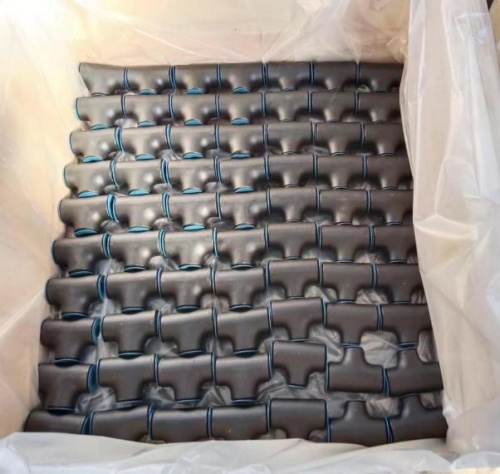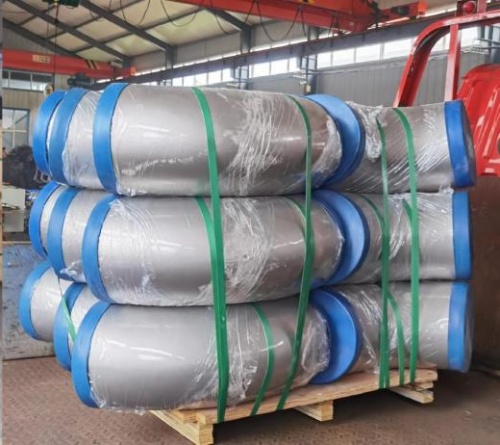On September 4, our company received an inquiry from a customer in Singapore about alloy steel butt weld pipe cap. We strictly control the quality of our products and provide excellent technical support to our customers.
We sent a quotation email, including price/material/delivery time/packaging, and sent a catalog and factory test certificate to the customer. At the same time, we contacted the customer and shared some inspection and packaging pictures with the customer.
On September 11, we received a purchase order from the customer and completed the production within 7 days. Some of the information in the order sent by the customer was incomplete. Our company’s salesperson supplemented the information and sent it to the customer for confirmation, which was affirmed by the customer.
ZIZI ENGEERING Co. Ltd. is a company specializing in the production and processing of pipes and fittings.
Introduction of Alloy Steel Butt Weld Pipe Cap
Alloy steel butt weld pipe cap is a pipe fitting welded to the end of a steel pipe to cover the pipe. It is mainly used to close the pipeline system to ensure that the fluid in the pipeline will not leak. It is usually welded at the end of the pipeline to provide a reliable sealing effect.
Alloy steel pipe caps are widely used in pipeline systems in the petroleum, chemical, electric power, metallurgy and other industries. Especially in high pressure, high temperature or highly corrosive environments, alloy steel butt weld pipe caps can provide a reliable sealing effect to ensure the safe operation of the pipeline system.
Specification of Alloy Steel Cap
| Size | 1/2” – 48” / DN15 – 1200 |
| Thickness | SCH 10 – SCH 160, XXS |
| Dimensions | ANSI / ASME B16.9 / MSS SP 43/JIS B2311/2312/2313/DIN2605/2615/2616/EN10253 |
| Alloy Steel | A234 WP5 / WP9 / WP11 / WP12 / WP22 /WP 91 / WP92 |
Characteristics of Alloy Steel Material
ASTM A234 is the material standard of American standard pipe fittings, which includes the grade of alloy steel, such as WP 5, WP 9, WP 11, WP 12, WP 22, WP 91, etc.
Chemical Composition
| CHEMICAL | LIMITS | C | Mn | P | S | Si | Cr | Mo |
| ASTM A234 WP5 CL1,CL3 | MIN | 0.30 | 4.00 | 0.440 | ||||
| MAX | 0.150 | 0.60 | 0.040 | 0.030 | 0.50 | 0.650 | ||
| ASTM A234 WP11 CL1 | MIN | 0.050 | 0.30 | 0.50 | 1.00 | 0.440 | ||
| MAX | 0.150 | 0.60 | 0.030 | 0.030 | 1.00 | 1.50 | 0.660 | |
| ASTM A234 WP11 CL2,CL3 | MIN | 0.050 | 0.30 | 0.50 | 1.00 | 0.440 | ||
| MAX | 0.200 | 0.80 | 0.040 | 0.040 | 1.00 | 1.50 | 0.650 | |
| ASTM A234 WP12 | MIN | 0.050 | 0.30 | 0.80 | 0.440 | |||
| MAX | 0.200 | 0.80 | 0.045 | 0.045 | 0.60 | 1.25 | 0.650 | |
| ASTM A234 WP22 CL1,CL3 | MIN | 0.050 | 0.30 | 1.90 | 0.870 | |||
| MAX | 0.150 | 0.60 | 0.040 | 0.040 | 0.50 | 2.60 | 1.130 |
Carbon is an important element in alloy steel butt weld pipe cap. It can improve the strength and hardness of alloys, but too high carbon content will reduce toughness and weld-ability. Therefore, the carbon content in the alloy needs to be controlled within a certain range, generally between 0.05%-0.2%.
Manganese is a commonly used alloying element. It can improve the strength and hardness of alloys while improving toughness. The manganese content is usually between 0.3%-0.8%. The right amount of manganese content helps to improve the overall performance of the alloy.
Mechanical Properties
| MATERIAL | T.S (MPA) | Y.S (MPA) | EL % |
| ASTM A234 WP5 CL1 | 415min | 205min | 30min |
| ASTM A234 WP5 CL3 | 520min | 310min | 30min |
| ASTM A234 WP11 CL1 | 415 min | 205 min | 30min |
| ASTM A234 WP11 CL2 | 485min | 275min | 30min |
| ASTM A234 WP11 CL3 | 520min | 310min | 30min |
| ASTM A234 WP12 CL1 | 415 min | 220min | 30min |
| ASTM A234 WP12 CL2 | 485 min | 275 min | 30min |
| ASTM A234 WP22 CL1 | 415 min | 205 min | 30min |
| ASTM A234 WP22 CL3 | 520min | 310min | 30min |
Yield strength is the stress when the material begins to produce significant plastic deformation. The yield strength of the alloy steel to the welded pipe cap is higher due to the reinforcement of the alloy elements. Tensile strength is the maximum stress that a material can withstand before tensile fracture.
How to Inspection

Appearance Inspection
The surface of the alloy steel butt weld pipe cap shall be flat without obvious bumps or wrinkles then check the weld. The weld shall be uniform and continuous, without biting edge, not welding, air holes and other defects.
Dimensional Inspection of Alloy Steel Butt Weld Pipe Cap
Use a caliper or a special pipe diameter measuring tool to measure the outer diameter of the pipe cap. When measuring, measure at different parts of the pipe cap to ensure that the diameter meets the specified tolerance range. For example, for an alloy butt-welded pipe cap with a nominal diameter of 168 mm, the tolerance of its outer diameter may be +2.4 mm,-1.6 mm.
Regarding the measurement of wall thickness, a wall thickness gauge is used to measure the wall thickness at multiple points on the circumference of the alloy steel butt weld pipe cap. The wall thickness of the alloy butt-welded pipe cap should be uniform and meet the design requirements.
Material Inspection
Use equipment such as a spectrometer to analyze the material composition of the pipe cap. Ensure that the content of alloy elements meets the corresponding standards or design requirements. Compare with the quality certificate of the material to check whether the material is consistent.
How to Pack Butt Weld Pipe Fittings
For the inner packaging of butt weld pipe fittings, we use plastic film, which can isolate air and moisture, and prevent butt-weld pipe fittings from rusting or corroding during storage and transportation. It can also prevent the surface of the pipe fittings from being scratched. During transportation and stacking, the pipe caps may rub against each other, and the plastic film can serve as a buffer layer to reduce surface damage.
Our outer packaging can be divided into three categories wooden box & pallet & cartons. According to the size and number of pipe caps, we design appropriate wooden box. Fix each pipe cap in the slot to prevent collision during transportation.
For small, large-volume and cost-sensitive butt-welded pipe fittings, we will choose cartons, which can be filled with foam, pearl cotton and other cushioning materials to protect the pipe fittings.
For a large number of butt weld pipe fittings, pallet packaging can achieve fast storage and transportation operations. Pallet packaging is to place multiple butt-welded pipe caps on a pallet and then fix them with plastic film or steel belts. The pallet can be made of wood, plastic or metal. This packaging method is convenient for forklift handling and mechanized loading and unloading, improving logistics efficiency.


